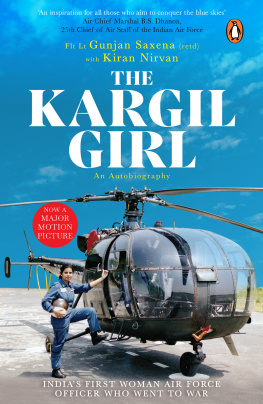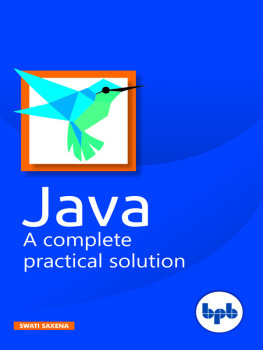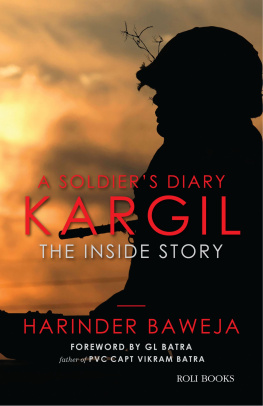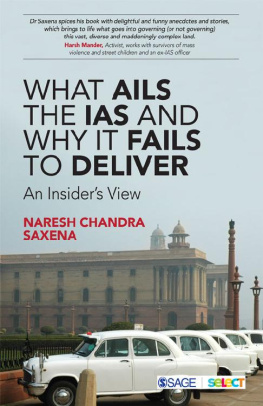Gunjan Saxena - The Kargil Girl
Here you can read online Gunjan Saxena - The Kargil Girl full text of the book (entire story) in english for free. Download pdf and epub, get meaning, cover and reviews about this ebook. year: 2020, publisher: Penguin Random House India Private Limited, genre: Non-fiction. Description of the work, (preface) as well as reviews are available. Best literature library LitArk.com created for fans of good reading and offers a wide selection of genres:
Romance novel
Science fiction
Adventure
Detective
Science
History
Home and family
Prose
Art
Politics
Computer
Non-fiction
Religion
Business
Children
Humor
Choose a favorite category and find really read worthwhile books. Enjoy immersion in the world of imagination, feel the emotions of the characters or learn something new for yourself, make an fascinating discovery.
- Book:The Kargil Girl
- Author:
- Publisher:Penguin Random House India Private Limited
- Genre:
- Year:2020
- Rating:4 / 5
- Favourites:Add to favourites
- Your mark:
- 80
- 1
- 2
- 3
- 4
- 5
The Kargil Girl: summary, description and annotation
We offer to read an annotation, description, summary or preface (depends on what the author of the book "The Kargil Girl" wrote himself). If you haven't found the necessary information about the book — write in the comments, we will try to find it.
The Kargil Girl — read online for free the complete book (whole text) full work
Below is the text of the book, divided by pages. System saving the place of the last page read, allows you to conveniently read the book "The Kargil Girl" online for free, without having to search again every time where you left off. Put a bookmark, and you can go to the page where you finished reading at any time.
Font size:
Interval:
Bookmark:




PENGUIN BOOKS

PENGUIN BOOKS
EBURY PRESS
Flight Lieutenant Gunjan Saxena (retd) is the first female Indian Air Force (IAF) officer to serve in the war zone. Long before the first female fighter pilots were commissioned into the IAF, she made history by flying a Cheetah helicopter in the Kargil War and rescuing several soldiers. Saxena was inspired to join the IAF by her father, who served in the Indian Army. As part of the family legacy, she decided to join the armed forces after completing her graduation from Delhi Universitys Hansraj College. In 1994, she cleared her Services Selection Board (SSB) interview and joined the Air Force Academy in Dundigal. When the Kargil War broke out in 1999, she helped turn things in Indias favour, becoming one of the first women on the front line.
Kiran Nirvan is the pseudonym used by authors Kirandeep Singh and Nirvan Singh. Together they have authored two bestselling booksNasteya: The Aryan Saga and 21 Kesaris: The Untold Story of the Battle of Saragarhi. The latter inspired the Akshay Kumar-starrer Kesari. Kirandeep Singh is the former head of the department of management studies, Global Institutes, Amritsar, and is currently pursuing his doctorate in the discipline. He began exploring his passion for writing in his teenage years and has authored more than a hundred poems, short stories, novels, song lyrics and couplets in both English and Punjabi. Nirvan Singh is a serving officer in the Indian Army, while also being an avid artist, writer and adventurer. It is his endeavour to write the stories of grit and determination, wisdom and valour, of men and women from the Indian armed forces, and other exemplary individuals of this nation.
21 Kesaris: The Untold Story of the Battle of Saragarhi
Nasteya: The Aryan Saga
To the heroes of the Kargil conflict
&
To this nations men and women in uniform,
serving and retired
At the outset, I would like to congratulate Flight Lieutenant Gunjan Saxena (retd) for writing her autobiography, as she has been a pathbreaker in her field! Being among the first few women officers who were given commission in the Flying Branch, she fought an uphill battle to break the stereotype of an Indian woman! Being part of the second course of women officers selected for helicopter-flying, she was assigned to a Cheetah/Chetak (Alouette III) unit in Udhampur, whose primary task was forward air control, which was to fly in the thick of combat during the erstwhile close air support/battlefield air strike (BAS) missions and visually guiding fighter aircraft to their targets.
In her book, Gunjan has successfully explained what it takes to become an officer in the Indian Air Force. Her retelling of the Kargil War made me go down memory lane and reminded me of my own experience in the war, wherein I was commanding 17 Squadron (Golden Arrows), where we worked closely with 132 FAC flight for all our BAS missions in the Kashmir Valley. During the Kargil conflict, as the main mode of attack had shifted to GPS-aided bombing from the classic BAS, Gunjans unit provided vital information about where our bombs were dropping relative to the target.
Post the ceasefire of sorts, her task was to carry me and the commanding officer of 108 Squadron for a recce sortie of the target area and a visit to 3 and 8 Division Headquarters at their operational locations. I was pleasantly surprised to see a calm and confident lady officer toting an AK-47 as her weapon in the Cheetah helicopter! In Kargil, I also happened to meet her brother Captain Anshuman Saxena of the Army Ordnance Corps. I asked them if their parents were on tenterhooks as both their children were deployed in the battle zone! The answer was a nonchalant no!
Later, she would earn the rightful title of The Kargil Girl, the first female Indian Air Force officers to serve in the battle zone. The Indian Air Force definitely needs more women officers like her, who can inspire young girls to dream of being combatants and serving their country.
I wish Gunjan and Kiran Nirvan the very best in their endeavour. I am sure this book will serve as an inspiration to future generations and for all those who aim to conquer the blue skies.
Jai Hind!
Air Chief Marshal Birender Singh Dhanoa
PVSM, AVSM, YSM, VM (retd)
25th Chief of Air Staff of the Indian Air Force

Do I really have it in me? I asked myself almost inaudibly. A strange silence fell over me as I stared at my reflection in the glass window of the AC coach. My train to Mysore had just arrived, and I was supposed to board soon.
Am I worthy of becoming an officer in the Indian armed forces? I asked myself, looking at my reflection, unmoving. Even the PA announcement by the railway station staff failed to distract me. Beads of sweat collected on my face and at the back of my neck. Whether it was my bodys mechanism of cooling itself down on a hot July afternoon, or just me perspiring out of nervousness, I could not tell. We had been waiting for the train at the platform in the scorching heat for an hour, and it may have well been the weather of Chennai. But then again, the opportunity that I had been eagerly waiting for was just hours away, so it could very well have been nervousness, after all.
The train will leave in five minutes. It was my fathers voice that pulled me back to reality. All of a sudden, discreet chatter, PA announcements, the incessant hollering of hawkers, the trains honking, the sound of a radio somewhere playing the title track from Hum Aapke Hain Kaun filled the air. In this country, railway stations have always been crowded and busy. I turned to look at my father. His handlebar moustache, a style he had sported back when I was a child, had given way to a simple chevron above his thin lips over the years. I could not recollect if it had been a sudden and deliberate change, or merely a trick of age. It still added to the overall charm of his long, chiselled face. His round black eyes had sunk deeper now and his face looked more weather-beaten than I remembered. Drops of sweat had settled on the contours of his long, straight nose and above his thin, stretched brows. There were two or more wrinkles under his chin that I hadnt spotted earlier. Even when his moderately long hair, swept back on his head, and the shorter hair on the sides, wasnt entirely black any more, there was no change in his commanding personality as he stood tall in front of me.
Dark patches of sweat had formed on his khaki shirt, which he was wearing with black bell-bottomed trousers, but he seemed as excited as he had been on the day I had received a call letter for the SSB (Services Selection Board). I remember how he had jumped up in excitement and hugged me. I remember how he had marked the dates on the calendar and noted instructions mentioned in the letter in his pocket diary. I remember how he had rushed to Avadi railway station to book a ticket for me to Mysore, how he had carefully collected items I would require for my SSB exam, how he had ensured I had packed everything according to the checklist. To me, getting recommended in the SSB meant a chance at a glorious career. To him, it was validation of his relentless efforts in bringing me up the way he had. To make sure I would not miss my train, he had rung up the railway enquiry office every few minutes that morning to confirm whether the train was on time. Back in those days, we did not have the luxury of checking a trains running status on the Internet. It was an analogue world, crisscrossed with wires and cables; the label wireless was still struggling to find its place. And I was struggling to hide my nervousness from Papaji.
Font size:
Interval:
Bookmark:
Similar books «The Kargil Girl»
Look at similar books to The Kargil Girl. We have selected literature similar in name and meaning in the hope of providing readers with more options to find new, interesting, not yet read works.
Discussion, reviews of the book The Kargil Girl and just readers' own opinions. Leave your comments, write what you think about the work, its meaning or the main characters. Specify what exactly you liked and what you didn't like, and why you think so.











